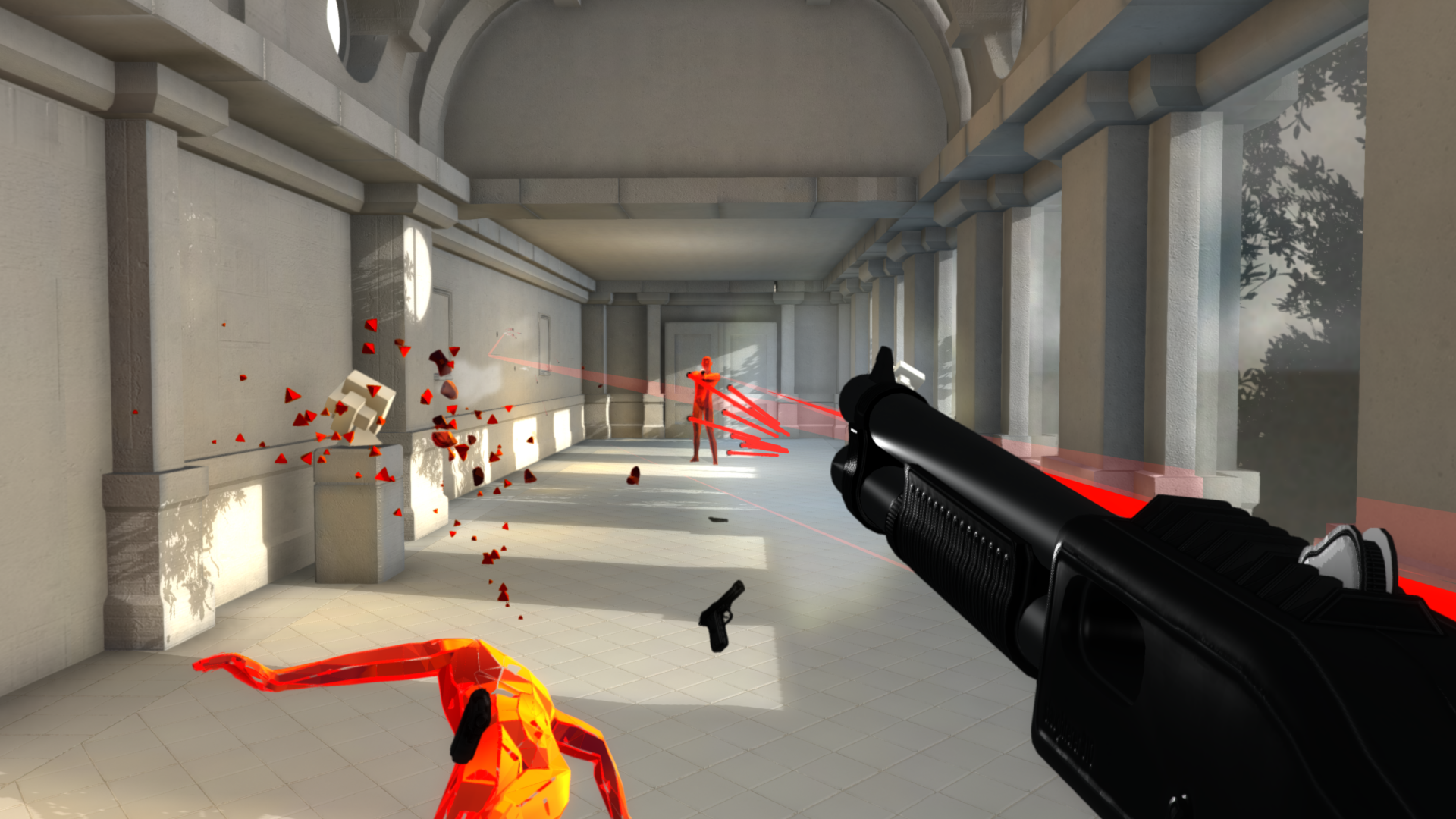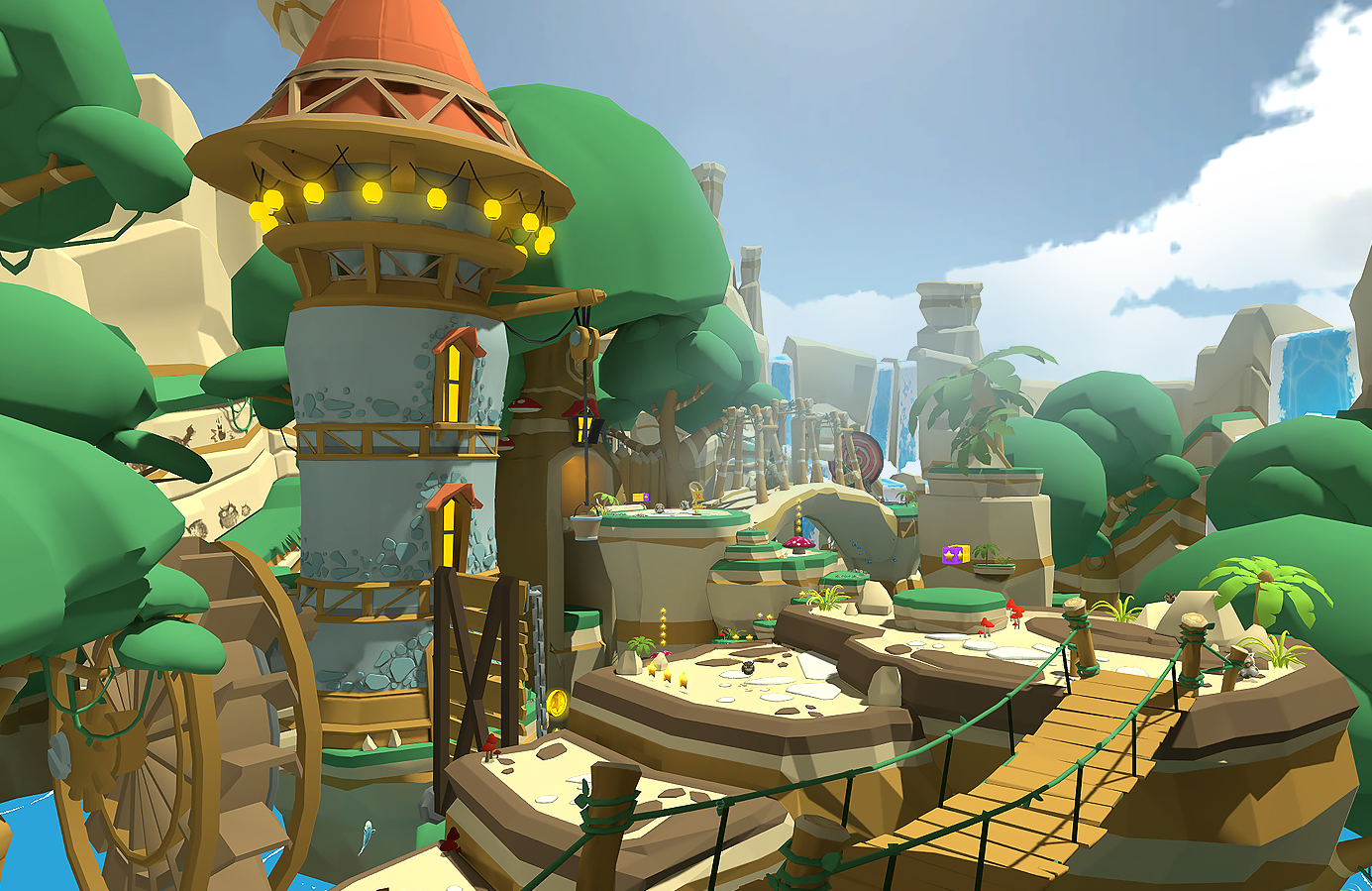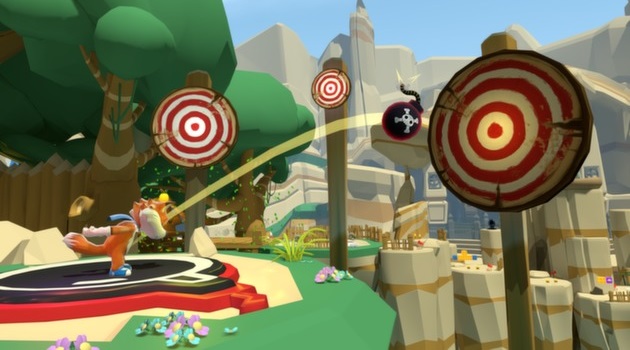Oculus Stretch Run: New Games, Talent, Challenges
Oculus invited Tom's Hardware to try some new Rift game prototypes during E3, highlighted the company's recent influx of high-profile talent, and generally discussed the state of its progress, post Facebook acquisition. I also tried to get a better understanding of the hardware required to run the Rift gaming experience effectively.
It all felt a little Hollywood. There were more and newer answers, and much still to be decided, but the buzz was definitely up several decibels, and the urgency was palpable.
For brevity's sake, I'll skip the part where we subject you to another rendition of how breathtaking and eye-opening the Oculus Rift gaming experience is and simply ask with the most pleading eyes and impatient, childlike whine: can't you just ship the damn thing already?
Despite all of the hullabaloo, attention, funding and high-profile hires, Oculus is intent on getting this right. Its biggest challenge is still on the content side, according to Nate Mitchell, Oculus VP of product.
GamePlay
On queue, then, I had a few minutes with Superhot (an existing web-based game), a port of Alien:Isolation (slated for October release on PS4), and a brand-new Oculus exclusive game called Lucky's Tale (no relation to Oculus founder Palmer Luckey).
Superhot is an FPS developed in Poland and funded through a now-expired Kickstarter campaign. There is an early prototype you can play on the web, but the VR version of it essentially lets you cheat the game a little. In Superhot, time moves when you move. You advance to grab a weapon, but bullets also come flying at you fast when you do. When you stop, the bullets slow down, and you can avoid them by maneuvering; you also force your own bullets toward the intended target with movement. The VR headset lets you move your head and body around the bullets, as when you're in The Matrix. When you do manage to grab the gun, you aim by looking at your target.
Get Tom's Hardware's best news and in-depth reviews, straight to your inbox.
Tom's Hardware's Kevin Parrish gave a brief hands-on assessment of his experiences with Alien: Isolation on the PS4, but I also played a version of this Creative Assembly/Sega game ported to work on VR in a joint effort with Oculus. This is really a stealth survival game, where it's more of a mistake to go on the hunt, as both Kevin and I were tempted to do. You are the hunted, and you rely on radar and motion detection to see the stalking alien. Playing the game with the Rift makes it a bit easier to keep the radar off to the side, and you can quite easily crouch behind things and look around in more dimensions. Mitchell said that one of the more interesting VR experiences in this game was seeing the monster drive a spike through you, among other death animations; unfortunately, we were merely devoured by the monster in an instant. This is one of those horror games made more horrific by a combination of eery scenery and sound, made that much more so with the added dimension of VR.
Lucky's Tale is an Oculus exclusive from Playful, a venture started by Paul Bettner, the co-creator of Newtoy's (now Zynga's) Words With Friends. Lucky's Tale is a platformer, inspired by Super Mario World 3D, and you can tell. Lucky is a fox that moves through a colorful world, collecting treasures, bouncing on monsters, and tossing bombs at targets (aiming by looking at the target). Somehow, Playful has managed to make this both a third-person game and provide immersion. You're able to see the world that Lucky is in just by looking up and around, or turning, or leaning over bridges or cliffs. I found myself slowing down on the quest just to take everything in. It's rather like a cartoon world tour baked into a game. I can't wait to see the stages built beyond what I witnessed.
I went back to feed more of my Lucky's Tale addiction and to talk with Bettner inside the incredibly busy Oculus booth, where we even saw Oculus CEO Brendan Iribe bouncing around, asking visitors for their impressions. Bettner was one of the early Oculus Kickstarter backers, but began his efforts based on id Software (and Doom) programmer John Carmack's tweets about the work Palmer Luckey was doing back before Oculus was fully formed. Bettner reached out to Luckey and immediately began working on prototypes.
Playful developed more than 30 different prototype ideas for the Oculus Rift in the early days, ranging from music games to an aquarium simulator, without any clue about what would work. Bettner's philosophy was to create something that could only be done because of the hardware platform, because of VR. He fully subscribes to Nintendo's philosophy in that regard, he said, even pointing out how Words With Friends emanated from thinking about what Nintendo would build for an iPhone-like platform.
Bettner desribed Lucky's Tale's emergence from the slate of prototypes like a wide-eyed toddler on Christmas morning. "When I saw it, I was like 'stop!' . . . it was a magical moment . . . we've never had this type of moment in a platfomer." That was five months ago, and Playful is pouring everything it has into Lucky's Tale, including numerous levels, mini games, boss battles and more. Oculus will publish the title, hopefully at launch, and Playful will retain the game's IP.
The game is surely more enticing than your every day platformer because you can combine hand-controller actions with head and body movements and, as Bettner said, be cooperative with the character, to the point where you can look at Lucky and he will actually turn and look back, make eye contact, and wiggle his nose. Playful wants to build on that connection and that cooperative experience such that the player and Lucky are working together to solve the game.
The Hardware Required for Oculus Rift
It's not difficult to imagine the hardware required to push these games to a full VR headset. Oculus' Mitchell said the current refresh rate target is 75 or 76 Hz, but the shipping product target is likely to be higher. That's pushing a display resolution of 960 x 1080 for each eye, at least in the DK2 version; Oculus won't comment on the final product resolution.
The latest headset prototype, DK2, now employs a low persistence OLED display as one technique to eliminate artifacts (and also motion sickness), and a built-in latency tester. An Oculus spokesman said that the DK2 includes a few technologies that allow for games dropping below the target frame rate without noticeable artifacts, but the details behind this will come later. I asked about the use of VSync, and again, the company wasn't ready to provide details.
Naturally, for gaming, Oculus Rift will require some fairly high-end hardware. Today, that's Nvidia's GeForce GTX 780 and Intel's Core i7-4770K. Mitchell said there will be recommended specifications that developers should target, but Oculus hasn't settled on how they'll do that just yet. Oculus won't lock out devices, he said, and while you could experience things like cinematic or video entertainment content driven by lesser hardware, games demand better.
To a great degree, as with any PC gaming experience, mileage will vary based on the game, including the possibility that some developers will want to drive even higher end experiences that require even more of a hardware investment.
Theoretically, Mitchell said, the best case scenario involves recommended floor settings (especially on frequency, which is critical to latency, comfort and presence) where you'll never drop a frame at a high frame rate, but developers can push functionality higher. Bettner added that there's really no flexibility in this "hard floor," and admitted that rendering 75 or 76 Hz onto two displays simultaneously is pretty serious from a hardware point of view. With Lucky's Tale, he said, Playful is not trying to have the most cutting edge graphical features, but a bright and colorful game everyone will want to play, but even with that, the floor is vital and Playful has even built in a little headroom. Bettner guessed that when the consumer Oculus Rift ships, it will be based on what we think of today as a high end gaming PC which, by then, might be a step down from the highest-end build.
We asked about the use of technology like G-Sync. Bettner offered that VR imposes an entirely new set of challenges, and that companies like Nvidia could consider designing a graphics card just for VR. It's not all that far fetched, Bettner said, pointing to the weight of people like John Carmack and other notable game luminaries under the Oculus roof. Of course, Nvidia would still have to see the market potential, but the company was rumored to be building something tailored to crypto currency mining.
We asked two different Nvidia representatives to speculate, but they wouldn't take the bait.
Oculus Draining Industry Gaming Talent
Bettner is correct in saying that Oculus now carries far more heft and influence. We'll get to the Facebook bit in a moment, but even before that, Oculus managed to capture a who's who in both hardware and gaming. That includes Jason Rubin, co-founder of Naughty Dog (Crash Bandicoot, Jak and Daxter, etc.), who will now head up Oculus WorldWide Studios (meaning internal product development); and Jason Holtman, former director of business development at Valve (and before that the head of gaming strategy at Microsoft), who now leads business development and partnerships on the platform side of the Oculus equation. Those aren't bad bookends.
Or how about Oculus chief scientist Michael Abrash and chief architect Atman Binstock, both also with Valve heritage? Or the lead engineer from EA (Paul Pedriana), or the lead engineer at Google Glass (Adrian Wong), or engineers and scientists from Nvidia and ARM? The company is up to about 120 employees, many of them on the software side, with an obvious emphasis on stoking more content for an official consumer launch.
Mitchell assured us, predictably, that Facebook's involvement hasn't shifted the company's focus, but instead is feeding it. Everything Oculus had planned to do will probably happen more quickly (and simultaneously) and with higher quality. He said that the company has many unannounced deals in the pipeline, indicating that it could be a busy second half of 2014. Oculus is ready to bet big, not just with its internal studios, but with its core technology for both internal and external developers, and in helping the external ones get off the ground quicker.
Facebook's backing and the talent ramp up is expected to help. Moreover, despite ongoing buyer jitters about Facebook's involvement, and what that could lead to, Mitchell pointed out that all of this incoming talent is comprised of game industry legends. While things like education and virtual tourism and other forms of entertainment will certainly be possibilities down the road, as they always were, for now, the company wants to nail gaming, period. I asked whether there would be a requirement to log into Facebook, or whether players would be able to game offline, and was assured that this depends entirely on the game developers and publishers, and that the Rift will be usable offline.
The pressure is on. Sony continued to showcase Morpheus, its own VR headset, during E3. Bettner, for one, thinks that's a good thing, that the VR field got a huge boost when Sony announced its long-rumored VR technology.
Lo and behold, while we were talking with Bettner inside the Oculus booth, he noticed Microsoft gaming exec Phil Harrison sauntering in to give the Oculus Rift and some of the new games a try.
-
jossrik Seriously looking forward to having an Oculus Rift to play with. RC Heli Sim Here We Come!Reply -
RCguitarist If the oculus does in fact require a minimum of a 780 and i7 4770k, it isn't going to sell enough to make it's investor happy (Facebook). Requiring that hardware would now make the oculus go from around a $300 device to a $1,300 device. It's not worth it at that price because with $1,300 i could keep my pc pushing 60fps on ultra settings on my 1080p monitor for the next 15 years, lol.Reply
That is going to be the biggest challenge for oculus, to keep the device as efficient as possible so that everyone with a decent gaming pc will buy one. Not to mention, that making this work with consoles will be a huge part of it's success...and they don't have 780s in them. -
skit75 There is nothing but PC talent behind OR. For console, all they would need to do is dumb it down. Console hardware is not changing for another 6 years. There are plenty of gaming PCs close to those specs with most just needing a GPU upgrade.Reply -
ammaross ReplyIf the oculus does in fact require a minimum of a 780 and i7 4770k, it isn't going to sell enough to make it's investor happy (Facebook). Requiring that hardware would now make the oculus go from around a $300 device to a $1,300 device. It's not worth it at that price because with $1,300 i could keep my pc pushing 60fps on ultra settings on my 1080p monitor for the next 15 years, lol.
Remember, this won't be out for another couple years; well enough time for 780s (actually, the new 870s) to become the norm of computer gaming for "enthusiast" class PC gamers. Someone like you, thinking you could game on dual 780s for the next 15 YEARS is an example of people who won't step up to a $300-500 piece of equipment. Early adopters will basically be those with 780s/870s or better anyway. Someone who thinks a $200 video card is "good enough" will blanch at a $500 VR headset pricetag the same way they blanch at the $500 price tag of a 1440p monitor currently.
That is going to be the biggest challenge for oculus, to keep the device as efficient as possible so that everyone with a decent gaming pc will buy one. Not to mention, that making this work with consoles will be a huge part of it's success...and they don't have 780s in them. -
Quarkzquarkz Oh great, so a 3770K + GTX 670 SLI is too slow for this? See I always get shafted like this and it ALWAYS happens to me for not having the 'recommended' requirements. I'm so pissed irght now.. =(Reply -
SinisterSalad You'll be fine, Quark. My current rig is slower than yours, and I don't believe I'll have any issues. I'll have to trim down the graphic settings on some games, but I'm fine with that. I've got the DK2 on order specifically to test hardware requirements for system builds. I have a triple monitor setup that I can play a lot of games just fine on, so I would think playing on a Rift should be fine as well.Reply -
fuzzion Although VR units are old tech expect such highres , high quality game exploiting this tech with DX12. This tech will reach peak maturity by 2021.Reply
For the moment everyone and their gaming rigs are fine.






